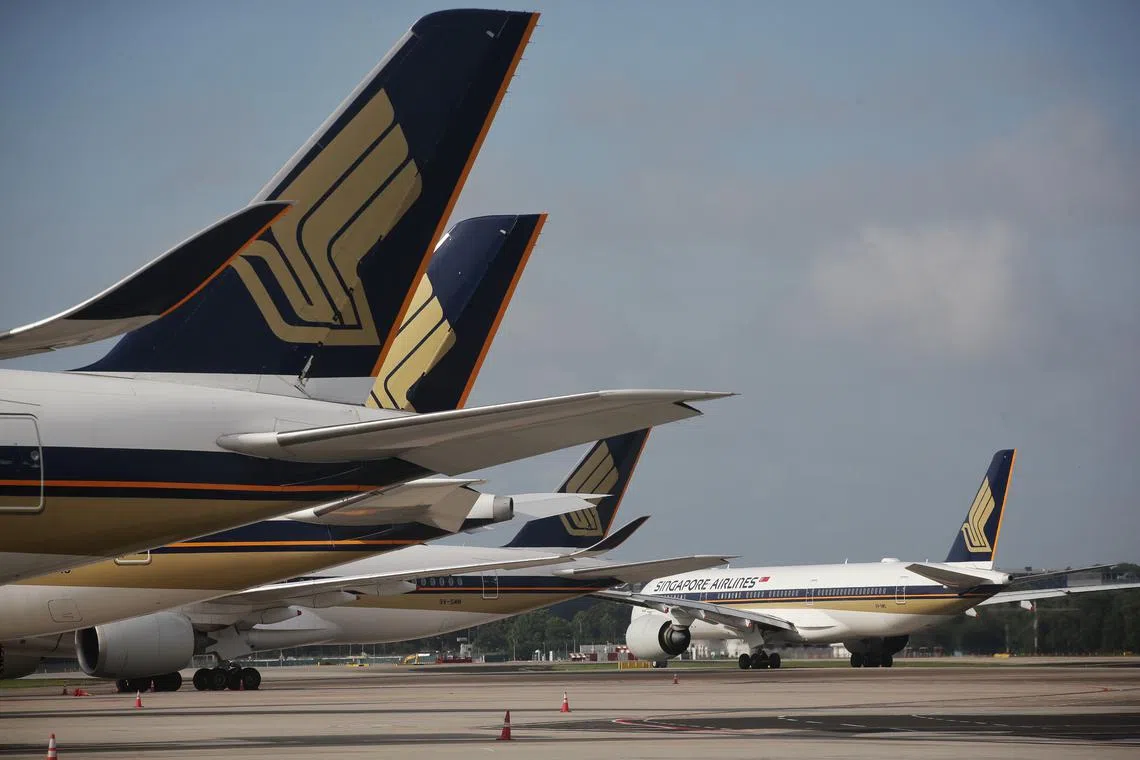Singapore Airlines beats Hong Kong’s Cathay Pacific in battle for the skies
Sign up now: Get ST's newsletters delivered to your inbox

Singapore Airlines is rebounding much faster and flying high on a relentless wave of travel demand.
PHOTO: ST FILE
Follow topic:
Hong Kong – The fortunes of Singapore Airlines (SIA) and Cathay Pacific Airways, the flagship airlines of two of Asia’s most important financial hubs, differed during the Covid-19 pandemic and continue to diverge in its aftermath.
Their valuations are revealing – SIA’s market value of US$17 billion (S$22.8 billion) is almost three times that of Cathay.
Four years ago, the difference was only about US$2 billion.
SIA just ended a 12-day run of gains, the longest streak since 2008, and is up about 40 per cent in 2023. Cathay has fallen 9.3 per cent.
While both are better placed than they were during the depths of Covid-19, SIA is rebounding much faster and flying high on a relentless wave of travel demand.
Its stock price reflects its status as “a poster child for the Asian airline recovery”, Bloomberg Intelligence analyst Tim Bacchus said.
Cathay’s rebuild, meanwhile, was severely hampered by the Hong Kong government’s reluctance to drop virus-related restrictions, and it is still struggling to restore staff numbers and services.
The airline does not expect to return to pre-pandemic levels of passenger capacity until the end of 2024.
A fresh and insatiable appetite for travel after Covid-19 lockdowns has not been dented by eye-popping airfares.
That has helped many airlines recover as they fill their planes with passengers willing to shell out on what has been dubbed “revenge travel”.
SIA posted record earnings of $2.16 billion for the year ended March, with revenue of $17.8 billion exceeding pre-Covid-19 levels.
Cathay’s position is improving too, but revenue of HK$51 billion (S$8.8 billion) in 2022 was still less than half of what it was in 2019, before the crisis.
The company has now, at least, generated enough cash to cover a HK$1.52 billion dividend payment due to the government at the end of June.
Revival rewards
Staff at SIA are seeing the benefits
Spirits are not so high at Cathay, where recently announced pay adjustments have been met with scepticism.
“Pilot morale is rock bottom,” Mr Paul Weatherilt, chairman of the union that represents Cathay pilots, said last week after the company revealed it was changing its salary policy. “They cut our pay permanently.”
SIA surges
SIA is one of the world’s best-performing airline stocks over the past three months, surging 34 per cent.
Only Taiwan’s Eva Airways has done better, rallying 56 per cent.
Singapore’s Straits Times Index is up about 2 per cent over that period.
Cathay has added 6.2 per cent.
SIA’s investors backed its effort to rebuild flight capacity, confident that it would lift earnings, said DBS Bank analyst Jason Sum.
Advanced bookings also look attractive as competitors such as Cathay face resource constraints, he added.
Rebuilding from Covid-19
SIA carried 2.8 million passengers in May, hitting 88 per cent of its pre-Covid-19 capacity and advancing towards the 3.4 million high set in January 2020.
Cathay’s passenger traffic was nearly 1.4 million in April, according to the most recent data available.
The airline has said it will return to only 70 per cent of pre-pandemic operation levels by the end of 2023.
While both airlines have been on a hiring spree, Cathay needs to climb out of a deeper trench.
Its staff attrition over the pandemic was nearly 40 per cent.
It also owes the government HK$19.5 billion that was extended in a rescue package.
Competitive edge
From its position of relative strength, SIA is cementing partnerships around the region with several airlines, including Garuda Indonesia, Malaysia Airlines, Thai Airways International and Vietnam Airlines.
The carrier and its low-cost unit Scoot are flying to 114 destinations again, while Cathay and HK Express are back to only 70. Prior to the pandemic, they served 136 and 119 places, respectively.
SIA and Scoot have 195 planes, while Cathay has 222, some of which remain in storage.
Long journey back
The speed at which Cathay can dust those jets off and bring them back into service will help determine its recovery to an extent, but it will be playing catch-up to SIA for some time yet, regardless.
“Our journey of rebuilding Cathay for Hong Kong is on the right track,” Cathay chief executive Ronald Lam said on June 6.
He did not mention his rival based 2,585km to the south.
BLOOMBERG

